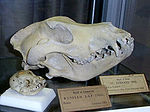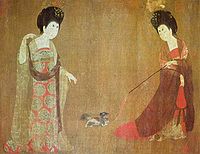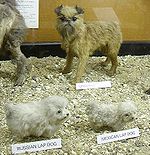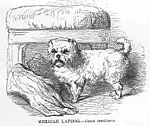
Lap dog
Encyclopedia
A lapdog or lap dog is a dog
that is small enough to be held in the arms or lie comfortably on a person's lap. Lapdogs are not a specific breed, but is a generic term for a type
of dog of small size and friendly disposition.
Lapdogs historically were kept in many societies around the world by individuals with leisure time, as docile companion
animals with no working function. Genetic analysis reveals that lapdogs are among the earliest specific types of dogs to live with people. Today, most lapdog breeds fall into the Toy
breed group.
 Some lapdogs have been bred for extremes of small size, such as the Russian and Mexican varieties shown below. Anatomically, lapdogs show distinct differences from their full-sized counterparts. The skull of the immature Russian lapdog from 1861 (possibly an ancestor of the Bolonka
Some lapdogs have been bred for extremes of small size, such as the Russian and Mexican varieties shown below. Anatomically, lapdogs show distinct differences from their full-sized counterparts. The skull of the immature Russian lapdog from 1861 (possibly an ancestor of the Bolonka
) specimen is approximately the size of a table-tennis ball and shows the relatively short muzzle and high forehead. Many lapdogs are bred to retain puppy-like traits (neoteny
) such as folded ears. Body proportions may also have changed, resulting in relatively short legs and large heads. They may also have traits that resemble human babies: size and weight, high forehead, short muzzle and relatively large eyes. Although selective breeding for such traits can have detrimental effects on tear ducts, dentition, and breathing, such traits also serve to
cause pet owners to derive more satisfaction from their pet relationship, as the pet owners may view dogs with this appearance as surrogate babies.
 Lapdogs have been used for pets, fashion accessories, status symbol
Lapdogs have been used for pets, fashion accessories, status symbol
s, and to provide warmth for the wealthy and fashionable. Lapdogs were also used in earlier times to attract fleas away from their owners. Some lapdogs were developed as pets while others, among the terrier
group, for example, were first bred for active work. Most kennel clubs list lapdog terriers in the Toy Group
.
Recent genetic study confirms that the Pekingese
lapdog, bred in ancient China to fit inside the sleeves of a man's robe, is one of the oldest breeds of dog. For centuries, they could be owned only by members of the Chinese Imperial Palace. Similarly ancient are the lapdog ancestors of the modern breeds of Tibetan Terrier
, Lhasa Apso
, Pug
, and Shih Tzu
.
In the book De Canibus Britannicis published in English in 1576, the author describes lapdogs as a type of dog
, "Spaniel
Gentle or Comforter". Ancestors of the modern breed of Cavalier King Charles Spaniel
were a type of "Spaniel Gentle" kept by English nobility in the 17th century.
Modern breeds
of lapdog also include the Pomeranian
, Japanese Terrier
, Maltese, Yorkshire Terrier
and many others.
 Papillon
Papillon
s' appearances in portraits of European royalty painted by the Old Masters indicate that the breed was favored as lapdogs as early as the 13th century.
and was also known as the Miniature Pekingese. The name Sleeve Pekingese came from the custom of carrying these small dogs in the capacious sleeves of the robes worn by members of the Chinese Imperial Household. Hubbard indicated that this tradition appeared to be early Italian rather than Chinese, but its adoption by the Chinese Imperial Household led to dogs being bred as small as possible and to practices aimed at stunting their growth: giving puppies rice wine, holding new-borns tightly for hours at a time or putting the puppies into tight-fitting wire mesh waistcoats. These practices were apparently forbidden by the late Dowager Empress Tzu Hsi.
In Hubbard's time, the term Sleeve was applied in Britain to a miniature Pekingese no more than 6–7 pounds in weight, often appearing to be only about 3–4 pounds. Mrs Flander’s Mai Mai weighed only a little over 4 pounds and many other breeders had bred true miniatures of a similar size. Hubbard noted that miniatures sometimes appeared in litters bred from full-sized Pekingese and were exhibited in classes for dogs less than 7 pounds at the major dog shows in Britain. At that time, the Sleeve Pekingese had a strong following with the most popular colours being cream and white.
s are by far the largest of the lap dogs. They originated in China at about 400 AD to satisfy the royalty of the Shang Dynasty. Pugs are famous for their wrinkled black face, curly tail, and snorting noises. Pugs became increasingly popular throughout the years and were transported all over Asia. Later on they were brought to Europe and finally to the Americas in the 20th century. These dogs share similar genes with pekingese dogs.
(singular and plural) is one of oldest breeds which roots trace back to Tibet and China where they were bred to resemble lions. They ideally range from 9-16 lbs and are considered an ideal lap dog for an out-going family.

 The Russian Lapdog and the Mexican Lapdog were not breeds in the modern sense, but were types of small dogs from Russia
The Russian Lapdog and the Mexican Lapdog were not breeds in the modern sense, but were types of small dogs from Russia
and Mexico
respectively. The individuals shown here are juveniles and are shown with a Griffon Bruxellois
to indicate scale. The immature Mexican Lapdog specimen is approximately the size of a golden hamster. Adult specimens are not on display. During the 19th century it was fashionable to mount immature specimens to look like adults, giving a false impression of adult size.
From: The Illustrated Natural History (Mammalia) by the Rev John George Wood
, 1853
has sometimes been called the worlds biggest lap dog.
The term lapdog is also used to describe a submissive person, such as a "yes" man, or an institution that can be very easily controlled (as in the lapdog press
in contrast to the tougher, more confronting watchdog press).
Dog
The domestic dog is a domesticated form of the gray wolf, a member of the Canidae family of the order Carnivora. The term is used for both feral and pet varieties. The dog may have been the first animal to be domesticated, and has been the most widely kept working, hunting, and companion animal in...
that is small enough to be held in the arms or lie comfortably on a person's lap. Lapdogs are not a specific breed, but is a generic term for a type
Dog type
Dog types are broad categories of dogs based on function, with dogs identified primarily by specific function or style of work rather than by lineage or appearance....
of dog of small size and friendly disposition.
Lapdogs historically were kept in many societies around the world by individuals with leisure time, as docile companion
Companion dog
Companion dog usually describes a dog that does not work, providing only companionship as a pet, rather than usefulness by doing specific tasks. Many of the toy dog breeds are used only for the pleasure of their company, not as workers...
animals with no working function. Genetic analysis reveals that lapdogs are among the earliest specific types of dogs to live with people. Today, most lapdog breeds fall into the Toy
Toy Group
Toy Group is the name of a breed Group of the smallest kinds of dogs, used by kennel clubs to classify a defined collection of dog breeds. Toy Group does not necessarily refer to one particular type of dog. Most major English-language kennel clubs include a Toy Group although different kennel clubs...
breed group.
Appearance

Bolonka
Bolonka — refers to small breeds of dog of the Bichon type, originally from Russia, developed from the Bichon Frisé and further developed in Germany. They include the Franzuskaya Bolonka and the Bolonka Zwetnaya...
) specimen is approximately the size of a table-tennis ball and shows the relatively short muzzle and high forehead. Many lapdogs are bred to retain puppy-like traits (neoteny
Neoteny
Neoteny , also called juvenilization , is one of the two ways by which paedomorphism can arise. Paedomorphism is the retention by adults of traits previously seen only in juveniles, and is a subject studied in the field of developmental biology. In neoteny, the physiological development of an...
) such as folded ears. Body proportions may also have changed, resulting in relatively short legs and large heads. They may also have traits that resemble human babies: size and weight, high forehead, short muzzle and relatively large eyes. Although selective breeding for such traits can have detrimental effects on tear ducts, dentition, and breathing, such traits also serve to
cause pet owners to derive more satisfaction from their pet relationship, as the pet owners may view dogs with this appearance as surrogate babies.
History and breeds

Status symbol
A status symbol is a perceived visible, external denotation of one's social position and perceived indicator of economic or social status. Many luxury goods are often considered status symbols...
s, and to provide warmth for the wealthy and fashionable. Lapdogs were also used in earlier times to attract fleas away from their owners. Some lapdogs were developed as pets while others, among the terrier
Terrier
A terrier is a dog of any one of many breeds or landraces of terrier type, which are typically small, wiry, very active and fearless dogs. Terrier breeds vary greatly in size from just a couple of pounds to over 70 pounds and are usually categorized by size or function...
group, for example, were first bred for active work. Most kennel clubs list lapdog terriers in the Toy Group
Toy Group
Toy Group is the name of a breed Group of the smallest kinds of dogs, used by kennel clubs to classify a defined collection of dog breeds. Toy Group does not necessarily refer to one particular type of dog. Most major English-language kennel clubs include a Toy Group although different kennel clubs...
.
Recent genetic study confirms that the Pekingese
Pekingese
The Pekingese, or "Peke" is an ancient breed of toy dog, originating in China. The breed was favored by the Chinese Imperial court, and its name refers to the city of Beijing where the Forbidden City resides...
lapdog, bred in ancient China to fit inside the sleeves of a man's robe, is one of the oldest breeds of dog. For centuries, they could be owned only by members of the Chinese Imperial Palace. Similarly ancient are the lapdog ancestors of the modern breeds of Tibetan Terrier
Tibetan Terrier
The Tibetan Terrier is not a member of the terrier group, the name being given to it by European travelers to Tibet who were reminded of terriers from back home when they first encountered the breed...
, Lhasa Apso
Lhasa Apso
The Lhasa Apso is a non-sporting dog breed originating in Tibet. It was bred as an interior sentinel in the Buddhist monasteries, who alerted the monks to any intruders who entered...
, Pug
Pug
The pug is a "toy" breed of dog with a wrinkly, short-muzzled face, and curled tail. The breed has a fine, glossy coat that comes in a variety of colors, and a compact square body with well-developed muscle. They have been described as multum in parvo , referring to the pug's personality and...
, and Shih Tzu
Shih Tzu
The Shih Tzu is a breed of dog weighing with long silky hair. The breed originated in China and is among the earliest breeds. Shih Tzu were officially recognized by the American Kennel Club in 1969...
.
In the book De Canibus Britannicis published in English in 1576, the author describes lapdogs as a type of dog
Dog
The domestic dog is a domesticated form of the gray wolf, a member of the Canidae family of the order Carnivora. The term is used for both feral and pet varieties. The dog may have been the first animal to be domesticated, and has been the most widely kept working, hunting, and companion animal in...
, "Spaniel
Spaniel
A spaniel is a type of gun dog. It is assumed spaniels originated from Spain as the word spaniel may be derived from Hispania or possibly from the French phrase "Chiens de l’Espagnol" . Spaniels were especially bred to flush game out of dense brush. By the late 17th century spaniels had become...
Gentle or Comforter". Ancestors of the modern breed of Cavalier King Charles Spaniel
Cavalier King Charles Spaniel
The Cavalier King Charles Spaniel is a small breed of Spaniel-type dog, and is classed as a toy dog by most kennel clubs. It is one of the most popular breeds in the United Kingdom. Since 2000, it has been growing in popularity in the United States. It is a smaller breed of spaniel, and Cavalier...
were a type of "Spaniel Gentle" kept by English nobility in the 17th century.
Modern breeds
Dog breed
Dog breeds are groups of closely related and visibly similar domestic dogs, which are all of the subspecies Canis lupus familiaris, having characteristic traits that are selected and maintained by humans, bred from a known foundation stock....
of lapdog also include the Pomeranian
Pomeranian (dog)
The Pomeranian is a breed of dog of the Spitz type, named for the Pomerania region in Central Europe . Classed as a toy dog breed because of its small size, the Pomeranian is descended from the larger Spitz type dogs, specifically the German Spitz...
, Japanese Terrier
Japanese Terrier
The is a small terrier native to Japan. It is believed to be descended from the progeny of fox terrier types, pointers and indigenous Japanese dogs. This dog is also known as the Nippon Terrier. The breed is rare, even in Japan.- Appearance :...
, Maltese, Yorkshire Terrier
Yorkshire Terrier
The Yorkshire Terrier is a small dog breed of terrier type, developed in the 19th century in the county of Yorkshire, England to catch rats in clothing mills. The defining features of the breed are its size, to , and its silky blue and tan coat...
and many others.
Papillon

Papillon (dog)
The papillon , also called the Continental Toy Spaniel, is a breed of dog of the Spaniel type. One of the oldest of the toy Spaniels, it derives its name from its characteristic butterfly-like look of the long and fringed hair on the ears. A papillon with dropped ears is called a phalène...
s' appearances in portraits of European royalty painted by the Old Masters indicate that the breed was favored as lapdogs as early as the 13th century.
Pekingese
According to the 1948 publication Dogs In Britain, A Description of All Native Breeds and Most Foreign Breeds in Britain by Clifford LB Hubbard, the Sleeve Pekingese was (in Hubbard's time) a true miniature of the standard-sized PekingesePekingese
The Pekingese, or "Peke" is an ancient breed of toy dog, originating in China. The breed was favored by the Chinese Imperial court, and its name refers to the city of Beijing where the Forbidden City resides...
and was also known as the Miniature Pekingese. The name Sleeve Pekingese came from the custom of carrying these small dogs in the capacious sleeves of the robes worn by members of the Chinese Imperial Household. Hubbard indicated that this tradition appeared to be early Italian rather than Chinese, but its adoption by the Chinese Imperial Household led to dogs being bred as small as possible and to practices aimed at stunting their growth: giving puppies rice wine, holding new-borns tightly for hours at a time or putting the puppies into tight-fitting wire mesh waistcoats. These practices were apparently forbidden by the late Dowager Empress Tzu Hsi.
In Hubbard's time, the term Sleeve was applied in Britain to a miniature Pekingese no more than 6–7 pounds in weight, often appearing to be only about 3–4 pounds. Mrs Flander’s Mai Mai weighed only a little over 4 pounds and many other breeders had bred true miniatures of a similar size. Hubbard noted that miniatures sometimes appeared in litters bred from full-sized Pekingese and were exhibited in classes for dogs less than 7 pounds at the major dog shows in Britain. At that time, the Sleeve Pekingese had a strong following with the most popular colours being cream and white.
Pug
PugPug
The pug is a "toy" breed of dog with a wrinkly, short-muzzled face, and curled tail. The breed has a fine, glossy coat that comes in a variety of colors, and a compact square body with well-developed muscle. They have been described as multum in parvo , referring to the pug's personality and...
s are by far the largest of the lap dogs. They originated in China at about 400 AD to satisfy the royalty of the Shang Dynasty. Pugs are famous for their wrinkled black face, curly tail, and snorting noises. Pugs became increasingly popular throughout the years and were transported all over Asia. Later on they were brought to Europe and finally to the Americas in the 20th century. These dogs share similar genes with pekingese dogs.
Chihuahua
Chihuahuas are one of the smallest lap dog breeds. They have their origins in Mexico. They are famous for their big pointy ears, high pitched bark, and small size.Shih Tzu
Shih TzuShih Tzu
The Shih Tzu is a breed of dog weighing with long silky hair. The breed originated in China and is among the earliest breeds. Shih Tzu were officially recognized by the American Kennel Club in 1969...
(singular and plural) is one of oldest breeds which roots trace back to Tibet and China where they were bred to resemble lions. They ideally range from 9-16 lbs and are considered an ideal lap dog for an out-going family.
Extinct lapdog breeds


Russia
Russia or , officially known as both Russia and the Russian Federation , is a country in northern Eurasia. It is a federal semi-presidential republic, comprising 83 federal subjects...
and Mexico
Mexico
The United Mexican States , commonly known as Mexico , is a federal constitutional republic in North America. It is bordered on the north by the United States; on the south and west by the Pacific Ocean; on the southeast by Guatemala, Belize, and the Caribbean Sea; and on the east by the Gulf of...
respectively. The individuals shown here are juveniles and are shown with a Griffon Bruxellois
Griffon Bruxellois
The Griffon Bruxellois or Brussels Griffon is a breed of toy dog, named for their city of origin: Brussels, Belgium. The Griffon Bruxellois may refer to three different breeds, the Griffon Bruxellois, the Griffon Belge and the Petit Brabançon...
to indicate scale. The immature Mexican Lapdog specimen is approximately the size of a golden hamster. Adult specimens are not on display. During the 19th century it was fashionable to mount immature specimens to look like adults, giving a false impression of adult size.
From: The Illustrated Natural History (Mammalia) by the Rev John George Wood
John George Wood
John George Wood, or Rev J. G. Wood, , was a popular English writer on natural history.Wood was born in London, son of surgeon John Freeman Wood and Juliana Lisetta, and educated at home, at Ashbourne grammar school and Merton College, Oxford ; also at Christ Church, where he worked for some time...
, 1853
- The very tiniest of the Dog family is the Mexican Lapdog, a creature so very minute in its dimensions as to appear almost fabulous to those who have not seen this animal itself. One of these little canine pets is to be seen in the British Museum, and always attracts much attention from the visitors. Indeed, if it were not in so dignified a locality, it would be generally classed with the mermaid, the flying serpent, and the Tartar lamb, as an admirable example of clever workmanship. It is precisely like those white woollen toy Dogs which sit upon a pair of bellows, and when pressed give forth a nondescript sound, intended to do duty for the legitimate canine bark. To say that it is no larger than these toys would be hardly true, for I have seen in the shop windows many a toy Dog which exceeded in size the veritable Mexican Lapdog.
Idiomatic use
Lapdog is also used jokingly to refer to a dog of any size that likes to climb onto a person's lap for affection. The Great DaneGreat Dane
The Great Dane , also known as German Mastiff or Danish Hound , is a breed of domestic dog known for its giant size...
has sometimes been called the worlds biggest lap dog.
The term lapdog is also used to describe a submissive person, such as a "yes" man, or an institution that can be very easily controlled (as in the lapdog press
News media
The news media are those elements of the mass media that focus on delivering news to the general public or a target public.These include print media , broadcast news , and more recently the Internet .-Etymology:A medium is a carrier of something...
in contrast to the tougher, more confronting watchdog press).

